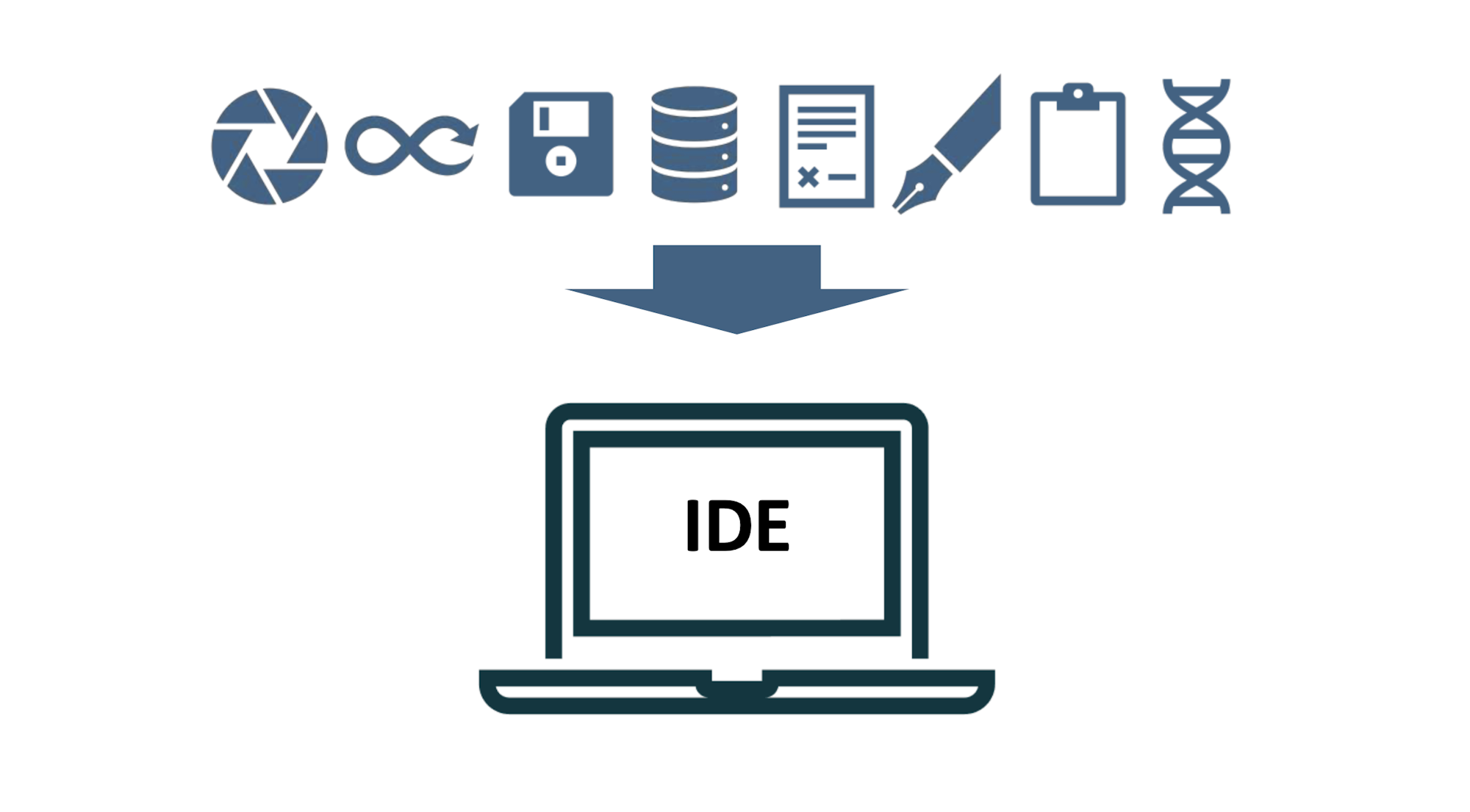
An IDE (integrated development environment) is software that combines all the functions needed for development in one place. Without an IDE, developers would need to use both a text editor to enter code and a separate compiler to make the program understandable to the computer. An IDE combines these features into one tool, making development more efficient.
Why IDEs are essential for developers
Before IDEs, building a development environment required configuring and operating multiple pieces of software separately. Using an IDE, developers can start iterating on new applications quickly, which is especially beneficial for beginners.

Software included in IDEs
-
Text editor: This software is used for inputting, editing, and saving text information. By making words bold or italic, changing font colors, the source code becomes more readable and syntax errors can be prevented.
-
Compiler: This software translates programming languages written by humans into a form that can be run by computers.
-
Linker: This tool converts the programming language transformed by the compiler into executable files that can be launched by the OS. Combining the work of the compiler and linker is called “building.”
-
Debugger: Used to identify and fix errors and bugs during software testing, debuggers allow developers to examine and modify the state of a program at specific points in its execution, helping to improve software quality.
The structure and benefits of IDEs
There are IDEs that are installed on your computer and those that are available from the cloud. While locally installed IDEs were popular in the past, there are now many cloud-based IDEs that don’t require installation on individual computers. Cloud-based IDEs allow for easy development using browsers like Google Chrome or Safari and enable sharing of development environments among multiple people.
Benefit 1: Saves time
Typically, setting up a development environment involves searching, installing, and configuring various software like text editors, compilers, linkers, and debuggers, which takes time and effort before starting development. With an IDE, all the necessary software for development is included, saving setup time.
Benefit 2: Facilitates team development
Sharing a single development environment among a team can prevent coordination errors related to version or source code management. Other individuals with access rights can easily edit the code, allowing quick debugging and error resolution. This helps reduce mistakes and improves work efficiency, benefiting team development.
Benefit 3: Prevents human error
IDEs include features such as predictive text (similar to the autocomplete function on mobile phones). Compilers also include a syntax checking tool that alerts users to mistakes in code formatting. Utilizing these features helps prevent human error and allows for efficient programming.
Benefit 4: Enhances code quality and efficiency
Many modern IDEs now include AI-driven code completion tools. Code generators can automatically produce boilerplate code and implement patterns, reducing monotonous work and ensuring adherence to best practices. AI debugging tools can also intelligently analyze code to identify not just syntax errors but also logical issues that might not be immediately apparent to developers.
Types of IDEs
Depending on the system or program being developed, one IDE may be more suitable than another. Knowing the selection criteria can help you choose an IDE that best suits your team.
Supported programming languages
While most IDEs are specialized for a single programming language, there are those that support multiple programming languages. Choose an IDE that aligns with the programming languages you plan to use.
Download vs. cloud
IDEs come in two forms: those that are downloaded and used directly on your computer and those that are cloud-based. If you download the IDE to use, it may be limited by the OS, like Android or iOS. With a cloud IDE, you can edit and compile directly in your browser without downloading software to your OS. Using a cloud IDE, you can share development environments, preventing errors caused by differences in individual computer configurations. Also, while building may require substantial memory and can slow down your computer, a cloud IDE relies on cloud storage, which can minimize speed issues.
Types of support and plugins
In addition to basic software like editors and compilers, some IDEs support tools for continuous integration and continuous deployment (CI/CD), or features like UI extensions for code editors, automatic testing capabilities, and more. Some IDEs even allow for customization through plugin installation to align with developers’ specific needs.
Examples of IDEs
Comes with Java by default and offers extensive extension capabilities supporting various languages.
Supports a wide range of languages focusing on Java and is compatible with Windows, Mac, and Linux. Developed around the same time as Eclipse.
Includes nearly all needed programming features and is used by programmers worldwide.
Supports various languages and allows for web service development. An open-source IDE that not only offers functionality extension through plugins but also requires minimal setup, making it a recommended IDE for beginners.
Additionally, there are many other IDEs such as Xcode for developing Apple apps and Android Studio for developing Android apps. Availability for commercial use, flexibility across multiple programming languages, and the extent of support differ between paid and free IDEs.
Conclusion
An integrated development environment (IDE) enhances developers’ productivity by consolidating the software such as text editors, compilers, linkers, and debuggers into one environment. Setting up a development environment doesn’t need to involve meticulous tasks like researching, installing, and configuring multiple pieces of software. IDEs can streamline this process, making it quicker and easier to start and manage development projects.
Once you have your IDE set up and are ready to start building, continue streamlining your development workflows with best practices like test-driven development and continuous integration. Sign up for a free CircleCI account today and see how intelligent automation can take your development process to the next level.






